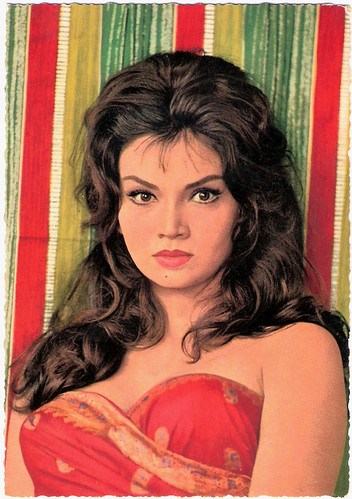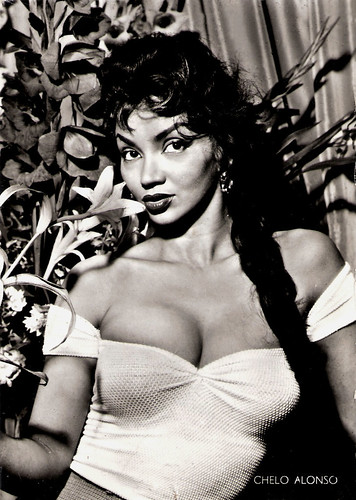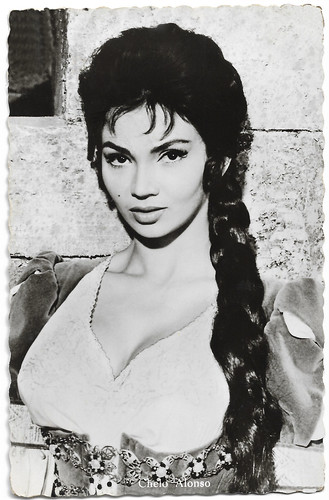Again, we have to announce that one of our film stars has passed away. Today, we learned that former Cuban actress, dancer and sex-symbol Chelo Alonso has died on 20 February 2019. Alonso was a star of the Italian cinema of the late 1950s and early 1960s. In several Peplum epics she played femme fatales with fiery tempers and she did sensual dance scenes, mixing Afro-Cuban rhythms with ‘bump and grind’. Ultimately in the DVD era, the ‘Cuban H-bomb’ became a cult heroine for many international B-film buffs. Chelo Alonso was 85.

German postcard by Krüger, no. 902/118.

German postcard by Krüger, no. 902/196. Photo: Gérard Decaux.
Darkly stunning Chelo Alonso was born Isabella Garcia in 1933 in Central Lugareño, Cuba, to a Cuban father and a Mexican mother. At a very young age, it became evident that Isabella possessed a great talent for dancing. At 17, she began performing seriously in Havana and soon earned notoriety at Cuba's National Theatre for her sensual, exotic style.
As Chelo Alonso, she toured many cities all over the world, including Havana, Puerto Rico, St. Domingo, Haiti, Miami, New Orleans, New York (Broadway), and finally, she arrived in Paris in 1957.
At the Folies Bergère, she was the main star and billed as the ‘new Josephine Baker’, who had become famous at the Folies more than 30 years before her. Alonso was billed as the ‘Cuban H-Bomb’, and mixed her native Latin Rhythms such as Mambo and Son, and fused them with the classic ‘bump and grind’.
Soon her sensual beauty and allure were discovered for the cinema. She went to the Mecca of the European film industry at the time, Rome. Many of Alonso's later films were Peplums, Italian sword and sandal films in the style of Le Fatiche di Ercole/Hercules (Pietro Francisci, 1958). This box office sensation had starred bodybuilder Steve Reeves and had created a wildly popular new film genre. Hercules paved the way for several Italian B-films attempting to emulate its success. These films required exotic talent, and Alonso's dark beauty fit the bill.
Chelo Alonso was first noticed internationally as Erica the slave dancer and conspirator in Nel segno di Roma/Sign of the Gladiator (Guido Brignone, 1959), which starred Anita Ekberg and Georges Marchal. Alonso’s billing was upped due to a particularly erotic dance number, and she became the second female lead. Her picture and name on the posters became even more prominent than either of the two stars, reportedly much to Anita Ekberg’s displeasure.
That year Alonso also played a princess opposite Lex Barker and Massimo Serrato in La Scimitarra del Saraceno/The Pirate and the Slave Girl (Piero Pierotti, 1959), and she starred with Steve Reeves himself in Il Terrore dei barbari/Goliath and the Barbarians (Carlo Campogalliani, 1959). Her part in the latter film earned Alonso the award of ‘Italian Cinema's Female Discovery’.

Italian postcard, no. 496.

Spanish postcard by Ediciones Europacolor, no. 272.

Dutch postcard. Sent by mail in 1963.
With her volcanic temperament, highly distinctive cheekbones and wild mane of dark hair, Chelo Alonso went on to star in a dozen Peplums and other adventure films. She charmed muscleman co-stars like Steve Reeves, Mark Forest, Jacques Sernas, Rik Battaglia and Gordon Mitchell in such films as Maciste nella valle dei re/Maciste the Mighty (Carlo Campogalliani, 1960), Terrore della maschera rossa/Terror of the Red Mask (Luigi Capuano, 1960), La regina dei tartari/The Queen of the Tartars (Sergio Grieco, 1960), and Morgan il pirata/Morgan the Pirate (André De Toth, Primo Zeglio, 1960).
That same year she also filmed a comedy, Gastone (Mario Bonnard, 1960), alongside two giants of the Italian cinema, Alberto Sordi and Vittoria De Sica. A year later, she married Aldo Pomilia, a production manager and producer whom she had met while working on Morgan the Pirate. She later bore him a son, Aldino.
Chelo reportedly refused Che Guevara's invitation to come back to Havana during the revolution, preferring to remain in Rome. Following Quattro notti don Alba/Desert War (Luigi Filippo D'Amico, 1962), Alonso left film for a time to turn her attention to television. She even took part in a cooking show, where the public could witness her preparing a typical Cuban meal of rice and chicken.
She did not return to the screen until the classic Spaghetti Western Il buono, il brutto, il cattivo/The Good, the Bad, and the Ugly (Sergio Leone, 1966). Ironically, in her most widely distributed film she only played a small, mute role. She played the unfortunate Mexican wife of Stevens (Antonio Casas) murdered by Lee Van Cleef in one of the film’s most striking sequences.
Then followed supporting parts in two other interesting Spaghetti Westerns. The first was the underrated Corri uomo corri/Big Gundown 2 (Sergio Sollima, 1968) starring Tomas Milian. Her final film was the obscure La Notte dei serpenti/Night of the Serpent (Giulio Petroni, 1970).
After the death of her producer-husband in 1986, Alonso moved to the city of Siena in Tuscany, Italy. She opened a small cat-breeding farm, which became a luxurious four-star hotel.
Chelo Alonso’s film career was brief, but we do agree with Ben Chenier at Cult Sirens: “She was in no more than 20 films but had she played in only one, we still couldn't forget her. (...) One of the most astounding beauty of her time (or any time, in my view), Chelo Alonso lit up the screen every time she appeared before a camera. That gorgeous figure, those amazing cheekbones, that heavy mane of hair... all elements to nominate her at the Pantheon of Immortal Movie Goddesses”.
Chelo Alonso died in Mentana, Lazio, Italy.
Trailer Il Terrore dei barbari/Goliath and the Barbarians (1959). Source: Sword and Sandal FLIX (YouTube).
Chelo Alonso's dance in Il Terrore dei barbari/Goliath and the Barbarians (1959). Source: ko ati (YouTube).
Sources: Ben Chenier (Cult Sirens), Gary Brumburgh (IMDb), Matt Blake (The Wild Eye), Wikipedia, and IMDb.

German postcard by Krüger, no. 902/118.

German postcard by Krüger, no. 902/196. Photo: Gérard Decaux.
Sensual, Exotic Style
Darkly stunning Chelo Alonso was born Isabella Garcia in 1933 in Central Lugareño, Cuba, to a Cuban father and a Mexican mother. At a very young age, it became evident that Isabella possessed a great talent for dancing. At 17, she began performing seriously in Havana and soon earned notoriety at Cuba's National Theatre for her sensual, exotic style.
As Chelo Alonso, she toured many cities all over the world, including Havana, Puerto Rico, St. Domingo, Haiti, Miami, New Orleans, New York (Broadway), and finally, she arrived in Paris in 1957.
At the Folies Bergère, she was the main star and billed as the ‘new Josephine Baker’, who had become famous at the Folies more than 30 years before her. Alonso was billed as the ‘Cuban H-Bomb’, and mixed her native Latin Rhythms such as Mambo and Son, and fused them with the classic ‘bump and grind’.
Soon her sensual beauty and allure were discovered for the cinema. She went to the Mecca of the European film industry at the time, Rome. Many of Alonso's later films were Peplums, Italian sword and sandal films in the style of Le Fatiche di Ercole/Hercules (Pietro Francisci, 1958). This box office sensation had starred bodybuilder Steve Reeves and had created a wildly popular new film genre. Hercules paved the way for several Italian B-films attempting to emulate its success. These films required exotic talent, and Alonso's dark beauty fit the bill.
Chelo Alonso was first noticed internationally as Erica the slave dancer and conspirator in Nel segno di Roma/Sign of the Gladiator (Guido Brignone, 1959), which starred Anita Ekberg and Georges Marchal. Alonso’s billing was upped due to a particularly erotic dance number, and she became the second female lead. Her picture and name on the posters became even more prominent than either of the two stars, reportedly much to Anita Ekberg’s displeasure.
That year Alonso also played a princess opposite Lex Barker and Massimo Serrato in La Scimitarra del Saraceno/The Pirate and the Slave Girl (Piero Pierotti, 1959), and she starred with Steve Reeves himself in Il Terrore dei barbari/Goliath and the Barbarians (Carlo Campogalliani, 1959). Her part in the latter film earned Alonso the award of ‘Italian Cinema's Female Discovery’.

Italian postcard, no. 496.

Spanish postcard by Ediciones Europacolor, no. 272.

Dutch postcard. Sent by mail in 1963.
Che Guevara's Invitation
With her volcanic temperament, highly distinctive cheekbones and wild mane of dark hair, Chelo Alonso went on to star in a dozen Peplums and other adventure films. She charmed muscleman co-stars like Steve Reeves, Mark Forest, Jacques Sernas, Rik Battaglia and Gordon Mitchell in such films as Maciste nella valle dei re/Maciste the Mighty (Carlo Campogalliani, 1960), Terrore della maschera rossa/Terror of the Red Mask (Luigi Capuano, 1960), La regina dei tartari/The Queen of the Tartars (Sergio Grieco, 1960), and Morgan il pirata/Morgan the Pirate (André De Toth, Primo Zeglio, 1960).
That same year she also filmed a comedy, Gastone (Mario Bonnard, 1960), alongside two giants of the Italian cinema, Alberto Sordi and Vittoria De Sica. A year later, she married Aldo Pomilia, a production manager and producer whom she had met while working on Morgan the Pirate. She later bore him a son, Aldino.
Chelo reportedly refused Che Guevara's invitation to come back to Havana during the revolution, preferring to remain in Rome. Following Quattro notti don Alba/Desert War (Luigi Filippo D'Amico, 1962), Alonso left film for a time to turn her attention to television. She even took part in a cooking show, where the public could witness her preparing a typical Cuban meal of rice and chicken.
She did not return to the screen until the classic Spaghetti Western Il buono, il brutto, il cattivo/The Good, the Bad, and the Ugly (Sergio Leone, 1966). Ironically, in her most widely distributed film she only played a small, mute role. She played the unfortunate Mexican wife of Stevens (Antonio Casas) murdered by Lee Van Cleef in one of the film’s most striking sequences.
Then followed supporting parts in two other interesting Spaghetti Westerns. The first was the underrated Corri uomo corri/Big Gundown 2 (Sergio Sollima, 1968) starring Tomas Milian. Her final film was the obscure La Notte dei serpenti/Night of the Serpent (Giulio Petroni, 1970).
After the death of her producer-husband in 1986, Alonso moved to the city of Siena in Tuscany, Italy. She opened a small cat-breeding farm, which became a luxurious four-star hotel.
Chelo Alonso’s film career was brief, but we do agree with Ben Chenier at Cult Sirens: “She was in no more than 20 films but had she played in only one, we still couldn't forget her. (...) One of the most astounding beauty of her time (or any time, in my view), Chelo Alonso lit up the screen every time she appeared before a camera. That gorgeous figure, those amazing cheekbones, that heavy mane of hair... all elements to nominate her at the Pantheon of Immortal Movie Goddesses”.
Chelo Alonso died in Mentana, Lazio, Italy.
Trailer Il Terrore dei barbari/Goliath and the Barbarians (1959). Source: Sword and Sandal FLIX (YouTube).
Chelo Alonso's dance in Il Terrore dei barbari/Goliath and the Barbarians (1959). Source: ko ati (YouTube).
Sources: Ben Chenier (Cult Sirens), Gary Brumburgh (IMDb), Matt Blake (The Wild Eye), Wikipedia, and IMDb.
No comments:
Post a Comment